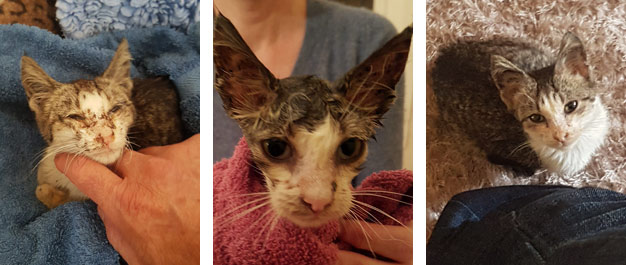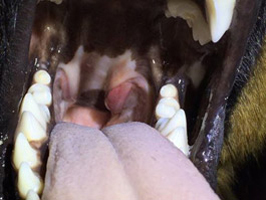
Another kitten was found – Could her skin lesions be ringworm?
What a kitten season in our clinic. Meanwhile 9 kittens have been brought to our clinic (found somewhere on the road, parks, motorway…) and we are very happy that they all are doing well.
Last week this adorable young kitten (Bunty) has been brought into our clinic and next to some minor other health issues she contracted ringworm. So, we thought we give you a short introduction into ring worm while we deal with it. The name ‘ringworm’ is somewhat of a misnomer in that it is not a worm nor does it always form a ‘ring’ pattern. A fungal organism causes these skin lesions that affects the top layer of the skin. The fungal spores can be picked up from the environment, from (shared) grooming products, from other pets and yes, occasionally from people who have ringworm lesions themselves. Vice versa, people can pick up ringworm from pets – that is called zoonosis.
Bunty has been evaluated at Ellerslie Veterinary Clinic shortly after being found with skin lesions in her face. Initially, ringworm infections may look too small to be important; just a little area of some dander and missing fur. But that is treacherous as the infection progresses fast in dogs and cats and the patient develops larger scaly and patchy areas. The fur typically falls out and if they chew or rub at the areas the skin can look red and irritated.
Many skin lesions can look similar so it is important to get a proper diagnosis to ensure a correct treatment plan. Bacterial infections often clear up quickly with antibiotics. However, patients with underlying allergies and / or fungal infections such as ringworm can be very challenging. Ringworm can be difficult to eliminate from the patient and from the environment.
Our veterinarian collected skin scrapes and looked under the microscope for organisms – mites, bacteria, fungal hyphae, or spores that help explain the cause of the skin lesions. Also, with the so-called Wood’s light evaluation some fungal organisms will fluorescence apple green under a special lamp that emits light in a specific wavelength. Unfortunately, if the skin lesion doesn’t fluoresce it doesn’t rule out fungal infections so other testing usually is needed.
Treatment for ringworm is focused on eliminating the infection from the pet and eliminating the spores in the environment. For the environment, it means treating the house and that requires diligent cleaning, disinfecting, vacuuming and laundering items that have been exposed. All this must be repeated for as long as the pet is positive for ringworm.
Treatment plans will vary depending on the species of fungi affecting the patient, the pet’s health, the extent of lesions, the number of patients to be treated (sometimes every pet in the household), the pet’s lifestyle (in/outdoor) and the response to the individual treatment. It is also important to consider the health of the people residing in the house as people with a weakened immune system are at higher risk of being infected themselves. The fungal spores can remain ineffective in the environment for a year or longer which makes this a challenging disease to overcome.
After one week on Medications Bunty’s face is a lot better. If your pet has skin lesions that are persistent or you are wondering if they could have ringworm, please don’t delay and seek the help of our skilled vet team, and ensure that your pet is getting the care they need.



Pingback: จำนำนาฬิกาหรู
Pingback: nfl|nfl highlights|nfl draft|nfl theme|nfl halftime show|nfl theme song|nfl draft 2023|nfl super bowl 2023|nfl 23|nfl 22|nfl halftime show 2022|nfl news|nfl live|nfl mock draft 2023|NFL player collapse|NFL live coverage|NFL Playoffs 2023|NFL game|NFL pred
Pingback: ขึ้นทะเบียน อย
Pingback: quik
Pingback: Cornhole bags near me